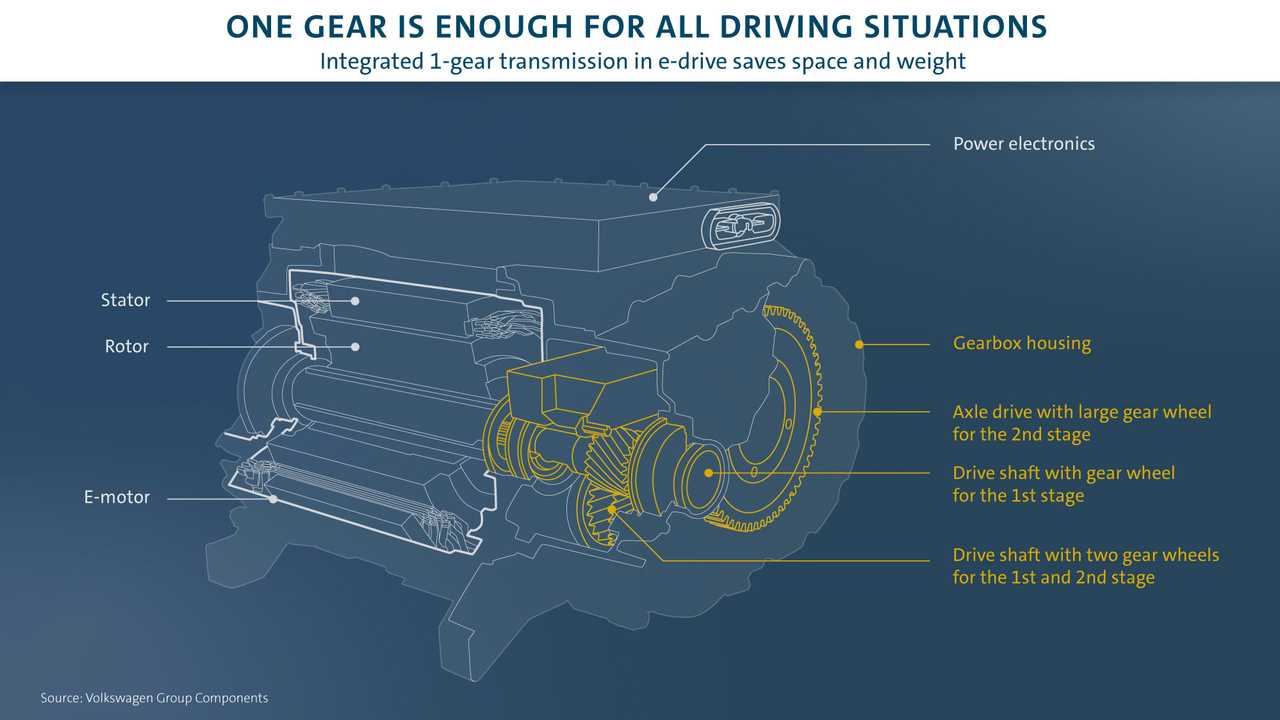Volkswagen continues the presentation of its MEB platform’s components and after shortly describing the motor and battery, now here’s the single-speed gearbox.
The gearboxes for MEB-based EVs, like the Volkswagen ID.3, will be produced by Volkswagen Group Components (in Kassel plant in Germany for the European and North American markets).
First of all, the APP310 e-drive unit is able to cover all driving situations with a single gear (similarly to most of the other EVs), thanks to high and widely available electric motor’s torque (with the possibility to reverse simply by changing the direction of rotation).
The transmission (reduction) ratio of the electric motor speed to the wheels is 10x. It’s a lot, because the highly efficient and compact electric motor reaches a 16,000 rpm maximum at speed of 160 km/h (100 mph).
To keep the size of the transmission small, Volkswagen decided to use two-stage reduction, with two smaller cogs instead of one big one.
“How power is transmitted to the wheels
The traction, i.e. the force that allows movement, and speed of a motor vehicle depend on the rotational speed of its drive system. As the speed of the drive system increases, the force transmitted to the wheels – the torque – can vary. With a vehicle with a combustion engine, the torque increases along with the engine speed and then falls again. With an electric drive system, however, the maximum torque is available immediately and remains constant over a wide range of speeds. The use of a multi-speed gearbox to achieve the desired speed or the necessary torque along the speed curve is therefore not absolutely necessary.
One gear for every situation
That is why a 2-stage 1-speed gearbox is used in the Volkswagen ID.3. When reversing the car, the direction of the electric drive system is simply reversed. In addition to various other components, power electronics is responsible for this and for the power characteristics of the drive system. In order to achieve the maximum power of 150 kW, the electric drive unit must rotate at high speeds. In order to provide a high level of torque, a 10x transmission ratio is used. To save space, the gearbox has a two-stage design with two smaller cogs instead of one big one. As a result, the electric drive motor in the ID.3 provides the maximum torque of 310 Nm constantly over a wide range of speeds. The maximum speed of 160 km/h is reached at a maximum of 16,000 rpm. For the ID.3 which is optimized for maximum range, the use of a single gear for all driving situations is perfectly adequate.”

Volkswagen APP 310 e-drive unit (MEB platform)
Interesting is that the silence of electric drive raised a new topic – the machine must be mechanically produced very precisely not only because of the high rotational speed, but also because the eventual noise would be heard by passengers.
“Precision manufacturing makes the e-vehicle particularly quiet
Because an electric drive system is very quiet, the level of noise in an e-vehicle is very important. Even the tiniest sources of noise can suddenly be heard. The parts for the 1-speed gearbox must therefore be manufactured with great precision to ensure that they do not cause any additional noise. At the end of the production line, not only the power characteristics of the electric drive system are checked – the relevant noise values are too. All drive systems for European and North American e-vehicles based on the MEB – including the 1-speed gearbox – are manufactured at the component plant in Kassel. Other important parts are produced at the component plants in Salzgitter, Poznań and Hannover.”
APP 310 electric drive for modular electric drive matrix (MEB):
- 150 kW (200 PS) of peak power
- 310 Nm of peak torque
- maximum electric motor speed of 16,000 rpm
- a permanent magnet brushless machine
- single-speed gearbox (10x reduction of transmission ratio using a two-stage design)
Here is a quick look at the VW production sites:

Production sites of the business unit transmission and e-drive (Volkswagen MEB platform)
…and the general fade of the manual transmission in ICE cars:

